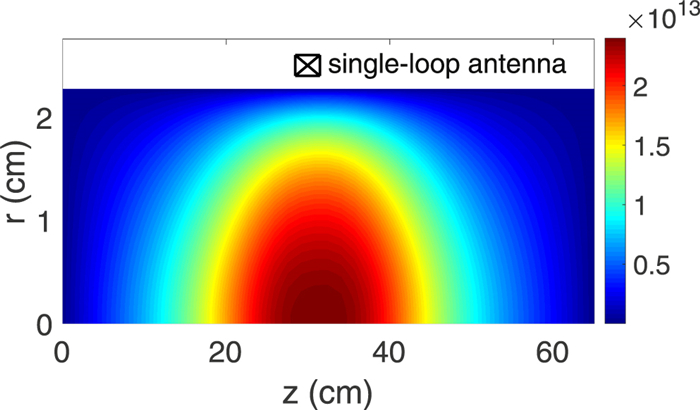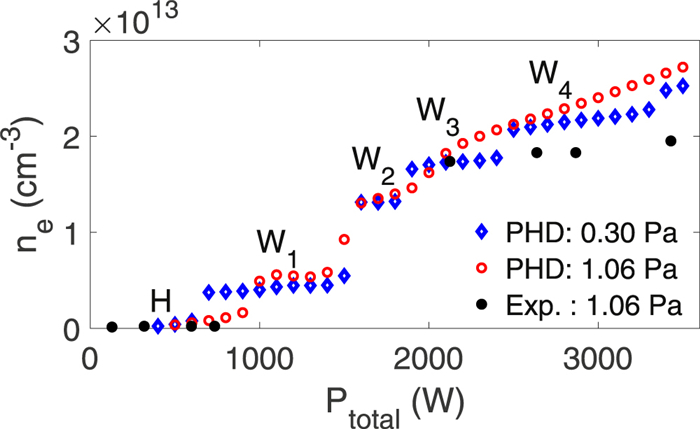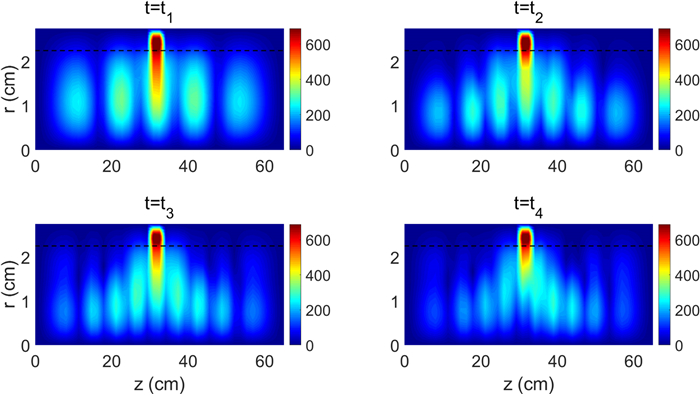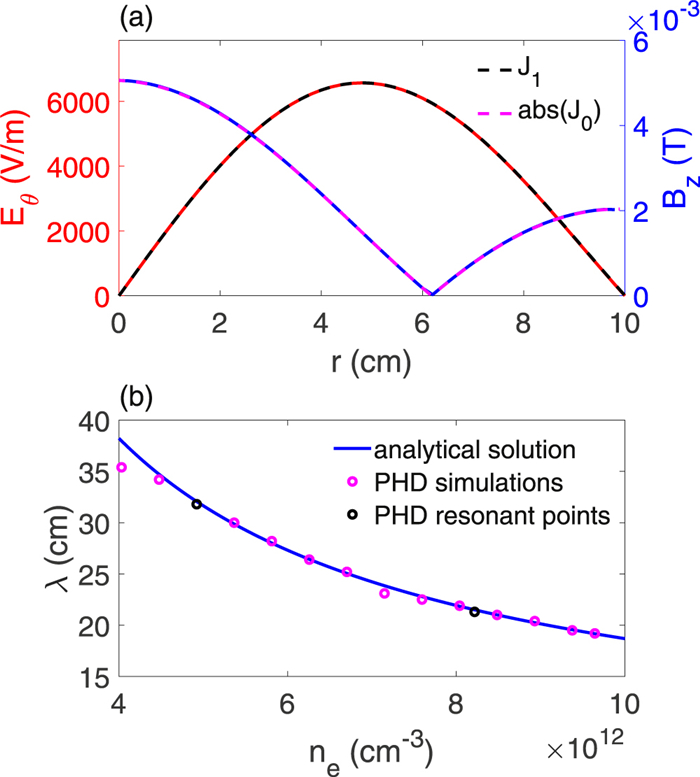
| Citation: | Mingyang WU, Chijie XIAO, Xiaogang WANG, Yue LIU, Min XU, Chang TAN, Tianchao XU, Xiuming YU, Renchuan HE, Andong XU. Relationship of mode transitions and standing waves in helicon plasmas[J]. Plasma Science and Technology, 2022, 24(5): 055002. DOI: 10.1088/2058-6272/ac567d |
Helicon wave plasma sources have the well-known advantages of high efficiency and high plasma density, with broad applications in many areas. The crucial mechanism lies with mode transitions, which has been an outstanding issue for years. We have built a fluid simulation model and further developed the Peking University Helicon Discharge code. The mode transitions, also known as density jumps, of a single-loop antenna discharge are reproduced in simulations for the first time. It is found that large-amplitude standing helicon waves (SHWs) are responsible for the mode transitions, similar to those of a resonant cavity for laser generation. This paper intends to give a complete and quantitative SHW resonance theory to explain the relationship of the mode transitions and the SHWs. The SHW resonance theory reasonably explains several key questions in helicon plasmas, such as mode transition and efficient power absorption, and helps to improve future plasma generation methods.
Producing high-density plasmas with high power efficiency is the central issue in plasma research, with broad applications in science and technology. Helicon wave plasma (HWP) sources are well known for their advantages of high power efficiency and high plasma density, as well as the feature of having no internal electrode [1, 2]. They thus have important applications in basic plasma research [3, 4], materials processing [5], current drive in tokamaks [6–8], electric propulsion [9–11], and many other areas. In particular, high density and high efficiency plasmas can greatly improve the use of energy and working media for better applications. The key to the high density and high efficiency of helicon plasmas lies on the transitions between various discharge modes, especially from the inductive (H) mode to the wave (W) modes, with significant density jumps [12, 13]. The H mode discharge exhibits low density and low power absorption efficiency. As the discharge power increases, the discharge will switch from H mode to W modes, accompanied by a rapid increase in density and power efficiency. Nevertheless, the physical mechanism of the mode transition is still an outstanding issue [14, 15].
Since Boswell discovered helicon plasmas in 1970 [16], their discharge mechanism has been studied extensively [14, 15, 17, 18]. Nevertheless, the calculated collisional absorption rate for helicon waves was much too low to explain the efficient ionization observed in experiments [16, 19]. Chen suggested that the Landau damping of the helicon waves possibly led to efficient power absorption [19]. On the other hand, however, experiments found that such Landau damping was unimportant to helicon plasmas [20]. Then, the strongly damped Trivelpiece-Gould (TG) wave was considered as the main heating mechanism [14, 21, 22]. However, the TG wave induced effects were expected to be important only for low dc magnetic fields and/or low plasma density [23, 24]. Nisoa et al further suggested a connection between high density and standing helicon waves (SHWs) [25, 26]. The presence of SHWs has been observed experimentally [13, 25–27], but the mechanism leading to the high density has not been clarified.
Clearly, the discharge mechanism in helicon plasmas has not been fully understood in previous studies. Thus there are still a few key issues to be resolved: (1) high efficient power absorption [28]; (2) mode transitions and different W modes [13]. There are also other questions to be answered, e.g., why W mode discharges can be realized by different antennas, such as helical, Nagoya, Boswell antennas, and even a single metal loop, etc [14]. In addition, the background magnetic field and measured densities are in agreement with the helicon wave dispersion relation [28]. Moreover, the lower the pressure is, the more pronounced the density jump is found in helicon discharges [13, 29].
Although many experiments have found density jumps [13, 26, 30, 31], direct simulation results are still lacking. The Peking University Helicon Discharge (PHD) code [32] has been developed to study the mechanism of helicon discharges. It is found in this work that the large-amplitude SHWs formed during the discharge processes are responsible for the mode transitions. The processes involved are as those of a resonant cavity for laser generation. The SHW resonance theory proposed in this work reasonably explains the key problems mentioned above. In addition, the SHW resonance theory can predict the conditions of density jumps and can be used to design HWP sources. Moreover, simulation results of the density jumps are presented for the first time. The simulations of the density jump and the theoretical analysis for the SHW resonance are presented as follows.
Argon discharge processes are numerically studied by the PHD code. A single-fluid model of equations (1)–(5) is applied, with basic discharge processes, such as ionizations, transports, and power depositions. The electromagnetic waves in vacuum and plasma areas can be described by Maxwell's equations (1) and (2) and the generalized Ohm's law equation (3) [1, 32].
| ∂B∂t=-∇×E, | (1) |
| ∂E∂t=1μ0ε0εr(∇×B-μ0(Ja+Jp)), | (2) |
| ∂Jp∂t=e2nemeE-emeJp×B0-νeJp, | (3) |
where
| ∂n∂t+∇·Γ=S, | (4) |
| 32∂∂t(nTe)+∇·qe=pp-HiS, | (5) |
where
| Γ=Da⊥∇⊥ne⊥+Da∇||ne||, | (6) |
| qe=-32n(Da⊥∇⊥Tee⊥+Da∇||Tee||)+52TeΓ, | (7) |
where subscripts
| Pt=1Trf∭ | (8) |
where
| (9) |
| (10) |
where
To compare the density jumps of the single-loop antenna between simulations and experiments, we use a configuration similar to that of [26], but with a slightly different antenna size. The configuration is shown in figure 1. In the cylindrical coordinate, the entire computational space is in the range of
When the initial density
We further discuss the density jumps with the applied magnetic field strengths. Figure 3 shows the variation of steady-state density with the applied magnetic field. It can be seen that the density and magnetic field show a good linear relationship in a certain magnetic field range. In the dispersion relation of helicon waves, if the wave number is assumed to be a constant, the density and the magnetic field are linear as well. Conversely, if the density and the magnetic field show a linear relationship, it can be inferred that the wave number is the same in that magnetic field range. The subsequent analysis in section 3 points out that a wave number corresponds to a wave mode discharge. In the 2000 W power discharge, three line segments with different slopes appear, and we infer that they are three different W mode discharges. In the 1000 W power discharge, the discharges of different magnetic fields are the same W mode. Further analysis is to be carried out in the next article.
For the W mode discharges, it is found that the plasma density undergoes the second and/or even multiple jumps over time, as shown in figure 4; the same as the results in [32].
A clear standing wave structure appears at the moments of
To further understand the mode transition, we then analyze the mechanism of the high electromagnetic power absorption in the helicon plasmas. That is, the equations (1)–(3) are studied in focus. Similar to Chen's analytical solution in cylindrical coordinates [19], with the polarization current and the electron inertia term neglected in equations (2) and (3), we have the azimuthal electric field
| (11) |
where
| (12) |
A perfect conductor boundary condition,
| (13) |
where
Equations (1)–(3) are numerically solved by the PHD code [32], in which the alternating-direction-implicit finite-difference time-domain (ADI-FDTD) method is used to improve computational efficiency [35, 36]. The schematic diagram of the simulation domain, which has analytic solutions, is shown in figure 6. In the cylindrical coordinate system, the entire computational space is in
The wave-driven boundary conditions are applied as
Both the electromagnetic field amplitude and the cycle-averaged power deposition are in steady state after
Figure 8(a) shows the dependence of
The power deposition can be written as
Thus, the numerical simulations predict that the large-amplitude SHWs lead to efficient power absorption and mode transitions. The formation mechanism of the large-amplitude SHWs is now discussed. The helicon wave is weakly damped and able to propagate over a long distance in the plasma. The wave is then reflected at the plasma boundary, with a mechanism described later, and superimposed to form SHWs, as shown in figure 6. When the SHW resonance condition,
| (14) |
is satisfied, where
Reflection is necessary for the formation of SHWs. The metal end plate can easily reflect helicon waves. On the insulated end plates, it is found that with a high plasma density and a strong magnetic field, the helicon wave can also be reflected by the insulated end plates almost completely. The analysis is as follows.
Figure 9 shows a helicon wave propagating parallel to the z-axis from medium 1 (the plasma with
| (15) |
Considering the strong magnetic field and high plasma density, the wavenumbers
| (16) |
The insulation boundary condition is applied as
| (17) |
| (18) |
where
| (19) |
| (20) |
The amplitude of the reflected wave is approximately equal to that of the incident wave, indicating the wave to be mostly reflected. The amplitude of the refracted wave is nearly twice that of the incident wave, while the energy of the refracted wave is derived from the magnetic energy in the incident wave. The reason for the almost total reflection is that the wave number in the plasma under a strong magnetic field is much larger than that in the vacuum, i.e. equation (16). The reflection on the insulated end plate is then consistent with the experimental results in [37] (figure 11), where the standing wave structures were observed for both conductor and insulated end plates.
Both simulations and experiments show that the lower the pressure is, the more pronounced the jumps are [13, 29]. The reason is that a lower pressure leads to a smaller collision frequency and damping rate of the wave. Thus, the helicon wave travels longer, the superimposed electric field intensity is bigger, and the power absorption peaks become narrower and higher. As a result, the discharge pattern jumps significantly at low pressure. In addition, as the steady-state density exceeds
In conclusion, the density jumps of a single-loop antenna discharge are reproduced in simulations for the first time and a complete and quantitative SHW resonance theory is presented in this paper. It is seen that the large-amplitude SHWs are responsible for the mode transitions, similar to those of a resonant cavity for laser generation. The SHW resonance theory reasonably explains the key problems of efficient power absorption and mode transitions. In addition, the analysis is independent of the antenna type. Therefore, the SHW resonance theory can be applied to plasmas excited by different types of helicon antennas. Moreover, the SHW resonance theory can also interpret: (1) the background magnetic field and measured densities are in agreement with the helicon wave dispersion relation; (2) the lower the pressure is, the more pronounced the density jump will be in helicon discharges. Finally, the mechanism of standing wave resonance can also be applied to other reflective or periodic systems to improve their efficiency, such as wave drive/heating in tokamak plasmas.
We would like to acknowledge Y Lang for useful discussions. This project was supported by the National Key R & D Program of China (No. 2017YFE0301201) and National Natural Science Foundation of China (No. 11975038). We acknowledge the funding support from the State Key Laboratory of Nuclear Physics and Technology, Peking University (No. NPT2021ZZ03).
| [1] |
Chen F F 1995 Helicon plasma sources High Density Plasma
Sources ed O A Popov (Park Ridge: William Andrew)
|
| [2] |
Longmier B W et al 2011 Plasma Sources Sci. Technol. 20 015007 doi: 10.1088/0963-0252/20/1/015007
|
| [3] |
Manz P et al 2011 Phys. Rev. Lett. 107 195004 doi: 10.1103/PhysRevLett.107.195004
|
| [4] |
Xiao C J et al 2016 Rev. Sci. Instrum. 87 11D610 doi: 10.1063/1.4961282
|
| [5] |
Bose D, Govindan T R and Meyyappan M 2003 IEEE Trans. Plasma Sci. 31 464 doi: 10.1109/TPS.2003.815475
|
| [6] |
Petrzilka V and Tataronis J A 1994 Plasma Phys. Control. Fusion 36 1027 doi: 10.1088/0741-3335/36/6/006
|
| [7] |
Lau C et al 2018 Nucl. Fusion 58 066004 doi: 10.1088/1741-4326/aab96d
|
| [8] |
Yang Y Q et al 2020 J. Fusion Energy 39 521 doi: 10.1007/s10894-020-00276-z
|
| [9] |
Squire J P et al 2006 Thin Solid Films 506–507 579 doi: 10.1016/j.tsf.2005.08.061
|
| [10] |
West M D, Charles C and Boswell R W 2009 J. Phys. D: Appl. Phys. 42 245201 doi: 10.1088/0022-3727/42/24/245201
|
| [11] |
Takahashi K et al 2011 Phys. Rev. Lett. 107 235001 doi: 10.1103/PhysRevLett.107.235001
|
| [12] |
Lieberman M A and Boswell R V 1998 J. Phys. IV France 8 Pr7-r145 doi: 10.1051/jp4:1998712
|
| [13] |
Chi K K, Sheridan T E and Boswell R W 1999 Plasma Sources Sci. Technol. 8 421 doi: 10.1088/0963-0252/8/3/312
|
| [14] |
Chen F F 2015 Plasma Sources Sci. Technol. 24 014001 doi: 10.1088/0963-0252/24/1/014001
|
| [15] |
Isayama S, Shinohara S and Hada T 2018 Plasma Fusion Res. 13 1101014 doi: 10.1585/pfr.13.1101014
|
| [16] |
Boswell R W 1970 Phys. Lett. A 33 457 doi: 10.1016/0375-9601(70)90606-7
|
| [17] |
Boswell R W 1975 Nature 258 58 doi: 10.1038/258058b0
|
| [18] |
Boswell R W and Chen F F 1997 IEEE Trans. Plasma Sci. 25 1229 doi: 10.1109/27.650898
|
| [19] |
Chen F F 1991 Plasma Phys. Control. Fusion 33 339 doi: 10.1088/0741-3335/33/4/006
|
| [20] |
Chen F F and Blackwell D D 1999 Phys. Rev. Lett. 82 2677 doi: 10.1103/PhysRevLett.82.2677
|
| [21] |
Arnush D and Chen F F 1998 Phys. Plasmas 5 1239 doi: 10.1063/1.872782
|
| [22] |
Blackwell D D et al 2002 Phys. Rev. Lett. 88 145002 doi: 10.1103/PhysRevLett.88.145002
|
| [23] |
Borg G G and Boswell R W 1998 Phys. Plasmas 5 564 doi: 10.1063/1.872748
|
| [24] |
Chen F F and Arnush D 1997 Phys. Plasmas 4 3411 doi: 10.1063/1.872483
|
| [25] |
Nisoa M, Sakawa Y and Shoji T 1999 Jpn. J. Appl. Phys. 38 L777 doi: 10.1143/JJAP.38.L777
|
| [26] |
Nisoa M et al 2000 Jpn. J. Appl. Phys. 39 L429 doi: 10.1143/JJAP.39.L429
|
| [27] |
Light M I et al 1995 Phys. Plasmas 2 4094 doi: 10.1063/1.871032
|
| [28] |
Boswell R W 1984 Plasma Phys. Control. Fusion 26 1147 doi: 10.1088/0741-3335/26/10/001
|
| [29] |
Zhang T L et al 2020 Plasma Sci. Technol. 22 085405 doi: 10.1088/2058-6272/ab8551
|
| [30] |
Ellingboe A R and Boswell R W 1996 Phys. Plasmas 3 2797 doi: 10.1063/1.871713
|
| [31] |
Franck C M, Grulke O and Klinger T 2003 Phys. Plasmas 10 323 doi: 10.1063/1.1528903
|
| [32] |
Wu M Y et al 2021 Plasma Sci. Technol. 23 085002 doi: 10.1088/2058-6272/ac0718
|
| [33] |
Chabert P and Braithwaite N 2011 Physics of Radio-Frequency Plasmas (Cambridge: Cambridge University Press)
|
| [34] |
Guittienne P et al 2021 Plasma Sources Sci. Technol. 30 075023 doi: 10.1088/1361-6595/ac0da3
|
| [35] |
Yuan C H and Chen Z H 2002 IEEE Trans. Microw. Theory Tech. 50 2401 doi: 10.1109/TMTT.2002.803450
|
| [36] |
Chen H L et al 2007 IEEE Microw. Wirel. Compon. Lett. 17 304 doi: 10.1109/LMWC.2007.892991
|
| [37] |
Motomura T et al 2012 Phys. Plasmas 19 043504 doi: 10.1063/1.3701558
|
| [1] | Ziqi FANG, Haohua ZONG, Yun WU, Hua LIANG, Zhi SU. Airfoil friction drag reduction based on grid-type and super-dense array plasma actuators[J]. Plasma Science and Technology, 2024, 26(2): 025503. DOI: 10.1088/2058-6272/ad0c99 |
| [2] | Yueqiang LI, Bin WU, Chao GAO, Haibo ZHENG, Yushuai WANG, Rihua YAN. Turbulent boundary layer control with DBD plasma actuators[J]. Plasma Science and Technology, 2023, 25(4): 045508. DOI: 10.1088/2058-6272/aca503 |
| [3] | Borui ZHENG, Yuanzhong JIN, Minghao YU, Yueqiang LI, Bin WU, Quanlong CHEN. Turbulent drag reduction by spanwise slot blowing pulsed plasma actuation[J]. Plasma Science and Technology, 2022, 24(11): 114003. DOI: 10.1088/2058-6272/ac72e2 |
| [4] | Hesen YANG, Hua LIANG, Shanguang GUO, Yanhao LUO, Mengxiao TANG, Chuanbiao ZHANG, Yun WU, Yinghong LI. Experimental study on surface arc plasma actuation-based hypersonic boundary layer transition flow control[J]. Plasma Science and Technology, 2022, 24(9): 095503. DOI: 10.1088/2058-6272/ac6d42 |
| [5] | Yueqiang LI (李跃强), Chao GAO (高超), Bin WU (武斌), Yushuai WANG (王玉帅), Haibo ZHENG (郑海波), Ming XUE (薛明), Yuling WANG (王玉玲). Turbulent boundary layer control with a spanwise array of DBD plasma actuators[J]. Plasma Science and Technology, 2021, 23(2): 25501-025501. DOI: 10.1088/2058-6272/abce0d |
| [6] | Lu MA (马璐), Xiaodong WANG (王晓东), Jian ZHU (祝健), Shun KANG (康顺). Effect of DBD plasma excitation characteristics on turbulent separation over a hump model[J]. Plasma Science and Technology, 2018, 20(10): 105503. DOI: 10.1088/2058-6272/aacdf0 |
| [7] | Haibao ZHANG (张海宝), Lijun SANG (桑利军), Zhengduo WANG (王正铎), Zhongwei LIU (刘忠伟), Lizhen YANG (杨丽珍), Qiang CHEN (陈强). Recent progress on non-thermal plasma technology for high barrier layer fabrication[J]. Plasma Science and Technology, 2018, 20(6): 63001-063001. DOI: 10.1088/2058-6272/aaacc8 |
| [8] | ZHANG Wenbo (张文波), WANG Shenggao (王升高), XU Chuanbo (许传波), XU Kaiwei (徐开伟), WANG Mingyang (王明洋), WANG Jianhua (汪建华), HUANG Zhiliang (黄志良), WANG Chuanxin (王传新). Reduction of Ilmenite Through Microwave Plasma[J]. Plasma Science and Technology, 2013, 15(5): 465-468. DOI: 10.1088/1009-0630/15/5/14 |
| [9] | LIN Zhihong (林志宏), S. ETHIER, T. S. HAHM, W. M. TANG. Verification of Gyrokinetic Particle Simulation of Device Size Scaling of Turbulent Transport[J]. Plasma Science and Technology, 2012, 14(12): 1125-1126. DOI: 10.1088/1009-0630/14/12/17 |
| [10] | SUN Yue (孙岳), CHEN Zhipeng (陈志鹏), WANG Zhijiang (王之江), ZHU Mengzhou (朱孟周), ZHUANG Ge (庄革), J-TEXT team. Experimental Studies of Electrostatic Fluctuations and Turbulent Transport in the Boundary of J-TEXT Tokamak Using Reciprocating Probe[J]. Plasma Science and Technology, 2012, 14(12): 1041-1047. DOI: 10.1088/1009-0630/14/12/02 |
| 1. | Kong, W., Dong, H., Wu, J. et al. Control of frictional and total drag by porous media at high Reynolds number wall turbulence conditions. Physics of Fluids, 2025, 37(3): 035205. DOI:10.1063/5.0260094 | |
| 2. | Zheng, B., Qi, S., Yu, M. et al. Turbulent drag reduction by sector-shaped counter-flow dielectric barrier discharge plasma actuator. Chinese Physics B, 2025, 34(2): 025205. DOI:10.1088/1674-1056/ada1c6 | |
| 3. | Su, Z., Zong, H., Liang, H. et al. Investigation of pulsed direct-current plasma jets in a turbulent boundary layer. Physics of Fluids, 2024, 36(3): 035128. DOI:10.1063/5.0190336 | |
| 4. | Zheng, H., Gao, C., Wu, B. et al. Drag reduction control of turbulent boundary layer based on plasma actuation | [基于等离子体激励的湍流边界层减阻控制]. Hangkong Dongli Xuebao/Journal of Aerospace Power, 2023, 38(5): 1157-1165. DOI:10.13224/j.cnki.jasp.20210546 | |
| 5. | SU, Z., ZONG, H., LIANG, H. et al. Minimizing airfoil drag at low angles of attack with DBD-based turbulent drag reduction methods. Chinese Journal of Aeronautics, 2023, 36(4): 104-119. DOI:10.1016/j.cja.2022.11.019 | |
| 6. | Yan, R., Wu, B., Gao, C. et al. Enhanced heat transfer in Poiseuille-Rayleigh-Bénard flows based on dielectric-barrier-discharge plasma actuation. Physics of Plasmas, 2023, 30(3): 033501. DOI:10.1063/5.0131414 | |
| 7. | Su, Z., Zong, H., Liang, H. et al. Optimization in frequency characteristics of an oscillating dielectric barrier discharge plasma actuator. Sensors and Actuators A: Physical, 2023. DOI:10.1016/j.sna.2023.114195 | |
| 8. | Xu, Z., Wu, B., Gao, C. et al. Experimental investigation of dynamic stall flow control using a microsecond-pulsed plasma actuator. Plasma Science and Technology, 2023, 25(3): 035509. DOI:10.1088/2058-6272/aca18f | |
| 9. | Zhang, X., Wang, X. RESEARCH PROGRESS AND OUTLOOK OF FLOW FIELD CREATED BY DIELECTRIC BARRIER DISCHARGE PLASMA ACTUATORS DRIVEN BY A SINUSOIDAL ALTERNATING CURRENT HIGH-VOLTAGE POWER | [正弦交流介质阻挡放电等离子体激励器诱导流场研究的进展与展望]. Lixue Xuebao/Chinese Journal of Theoretical and Applied Mechanics, 2023, 55(2): 285-298. DOI:10.6052/0459-1879-22-377 | |
| 10. | Zhao, J., Zhang, H., Meng, X. et al. Aerodynamic effects of a tube-type AC-SDBD plasma actuator. 2023. DOI:10.2514/6.2023-3747 | |
| 11. | Su, Z., Zong, H., Liang, H. et al. Progress and outlook of plasma-based turbulent skin-friction drag reduction | [等离子体湍流摩擦减阻研究进展与展望]. Kongqi Donglixue Xuebao/Acta Aerodynamica Sinica, 2023, 41(9): 1-19. DOI:10.7638/kqdlxxb-2023.0083 | |
| 12. | Chen, J., Zong, H., Song, H. et al. AI-based real-time noise reduction of flow field pressure signals under plasma electromagnetic interference | [等离子体电磁干扰下圆柱绕流壁面压力信号 AI 实时降噪]. Shiyan Liuti Lixue/Journal of Experiments in Fluid Mechanics, 2023, 37(4): 59-65. DOI:10.11729/syltlx20230030 | |
| 13. | Zong, H., Wu, Y., Liang, H. et al. Experimental Investigation and Intelligent Optimization of Airfoil Zero-Lift Drag Reduction with Plasma Actuators. AIAA Journal, 2023, 61(1): 223-240. DOI:10.2514/1.J062099 | |
| 14. | Hui, W., Meng, X., Li, H. et al. Flow induced by a pair of plasma actuators on a circular cylinder in still air under duty-cycle actuation. Physics of Fluids, 2022, 34(12): 123613. DOI:10.1063/5.0124744 | |
| 15. | ZHENG, B., JIN, Y., YU, M. et al. Turbulent drag reduction by spanwise slot blowing pulsed plasma actuation. Plasma Science and Technology, 2022, 24(11): 114003. DOI:10.1088/2058-6272/ac72e2 | |
| 16. | Zong, H., Su, Z., Liang, H. et al. Experimental investigation and reduced-order modeling of plasma jets in a turbulent boundary layer for skin-friction drag reduction. Physics of Fluids, 2022, 34(8): 0104609. DOI:10.1063/5.0104609 | |
| 17. | Li, Y., Wu, Y., Liang, H. et al. Exploration and outlook of plasma-actuated gas dynamics | [等离子体激励气动力学探索与展望]. Advances in Mechanics, 2022, 52(1): 1-32. DOI:10.6052/1000-0992-21-044 | |
| 18. | Zhu, Z., Fradera-Soler, P., Jo, W. et al. Numerical simulation of the flow around a square cylinder under plasma actuator control. Physics of Fluids, 2021, 33(12): 123611. DOI:10.1063/5.0072081 | |
| 19. | Zhao, L., Xiao, Z., Liu, F. Simulation of flow induced by single-dielectric-barrier-discharge plasma actuator using a high-order flux-reconstruction scheme. Physics of Fluids, 2021, 33(4): 047108. DOI:10.1063/5.0046900 | |
| 20. | Li, Y., Gao, C., Wu, B. et al. Turbulent boundary layer control with a spanwise array of DBD plasma actuators. Plasma Science and Technology, 2021, 23(2): 025501. DOI:10.1088/2058-6272/abce0d |


